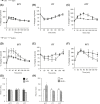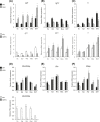Insulin, IGF-1, and GH Receptors Are Altered in an Adipose Tissue Depot-Specific Manner in Male Mice With Modified GH Action
- PMID: 28323915
- PMCID: PMC5460824
- DOI: 10.1210/en.2017-00084
Insulin, IGF-1, and GH Receptors Are Altered in an Adipose Tissue Depot-Specific Manner in Male Mice With Modified GH Action
Abstract
Growth hormone (GH) is a determinant of glucose homeostasis and adipose tissue (AT) function. Using 7-month-old transgenic mice expressing the bovine growth hormone (bGH) gene and growth hormone receptor knockout (GHR-/-) mice, we examined whether changes in GH action affect glucose, insulin, and pyruvate tolerance and AT expression of proteins involved in the interrelated signaling pathways of GH, insulinlike growth factor 1 (IGF-1), and insulin. Furthermore, we searched for AT depot-specific differences in control mice. Glycated hemoglobin levels were reduced in bGH and GHR-/- mice, and bGH mice displayed impaired gluconeogenesis as judged by pyruvate tolerance testing. Serum IGF-1 was elevated by 90% in bGH mice, whereas IGF-1 and insulin were reduced by 97% and 61% in GHR-/- mice, respectively. Igf1 RNA was increased in subcutaneous, epididymal, retroperitoneal, and brown adipose tissue (BAT) depots in bGH mice (mean increase ± standard error of the mean in all five depots, 153% ± 27%) and decreased in all depots in GHR-/- mice (mean decrease, 62% ± 4%). IGF-1 receptor expression was decreased in all AT depots of bGH mice (mean decrease, 49% ± 6%) and increased in all AT depots of GHR-/- mice (mean increase, 94% ± 8%). Insulin receptor expression was reduced in retroperitoneal, mesenteric, and BAT depots in bGH mice (mean decrease in all depots, 56% ± 4%) and augmented in subcutaneous, retroperitoneal, mesenteric, and BAT depots in GHR-/- mice (mean increase: 51% ± 1%). Collectively, our findings indicate a role for GH in influencing hormone signaling in AT in a depot-dependent manner.
Copyright © 2017 Endocrine Society.
Figures






Similar articles
-
Depot-specific and GH-dependent regulation of IGF binding protein-4, pregnancy-associated plasma protein-A, and stanniocalcin-2 in murine adipose tissue.Growth Horm IGF Res. 2018 Apr;39:54-61. doi: 10.1016/j.ghir.2018.01.001. Epub 2018 Feb 3. Growth Horm IGF Res. 2018. PMID: 29398370
-
Fibroblast growth factor 21, fibroblast growth factor receptor 1, and β-Klotho expression in bovine growth hormone transgenic and growth hormone receptor knockout mice.Growth Horm IGF Res. 2016 Oct-Dec;30-31:22-30. doi: 10.1016/j.ghir.2016.08.003. Epub 2016 Aug 24. Growth Horm IGF Res. 2016. PMID: 27585733
-
Tissue-specific regulation of growth hormone (GH) receptor and insulin-like growth factor-I gene expression in the pituitary and liver of GH-deficient (lit/lit) mice and transgenic mice that overexpress bovine GH (bGH) or a bGH antagonist.Endocrinology. 2004 Apr;145(4):1564-70. doi: 10.1210/en.2003-1486. Epub 2004 Jan 15. Endocrinology. 2004. PMID: 14726438
-
Growth hormone (GH) binding and effects of GH analogs in transgenic mice.Proc Soc Exp Biol Med. 1994 Jul;206(3):190-4. doi: 10.3181/00379727-206-43740. Proc Soc Exp Biol Med. 1994. PMID: 8016152 Review.
-
Altered structure and function of adipose tissue in long-lived mice with growth hormone-related mutations.Adipocyte. 2017 Apr 3;6(2):69-75. doi: 10.1080/21623945.2017.1308990. Epub 2017 Mar 21. Adipocyte. 2017. PMID: 28425851 Free PMC article. Review.
Cited by
-
The endocrine function of adipose tissues in health and cardiometabolic disease.Nat Rev Endocrinol. 2019 Sep;15(9):507-524. doi: 10.1038/s41574-019-0230-6. Epub 2019 Jul 11. Nat Rev Endocrinol. 2019. PMID: 31296970 Review.
-
GHR-/- Mice are protected from obesity-related white adipose tissue inflammation.J Neuroendocrinol. 2020 Nov;32(11):e12854. doi: 10.1111/jne.12854. Epub 2020 Apr 29. J Neuroendocrinol. 2020. PMID: 32350959 Free PMC article.
-
Dynamic changes in the distribution of facial and abdominal adipose tissue correlated with surgical treatment in acromegaly.Endocrine. 2018 Dec;62(3):552-559. doi: 10.1007/s12020-018-1742-x. Epub 2018 Sep 10. Endocrine. 2018. PMID: 30203120
-
Differential gene signature in adipose tissue depots of growth hormone transgenic mice.J Neuroendocrinol. 2020 Nov;32(11):e12893. doi: 10.1111/jne.12893. Epub 2020 Oct 12. J Neuroendocrinol. 2020. PMID: 33043505 Free PMC article.
-
Effect of growth hormone on insulin signaling.Mol Cell Endocrinol. 2020 Dec 1;518:111038. doi: 10.1016/j.mce.2020.111038. Epub 2020 Sep 20. Mol Cell Endocrinol. 2020. PMID: 32966863 Free PMC article. Review.
References
-
- Mozaffarian D, Benjamin EJ, Go AS, Arnett DK, Blaha MJ, Cushman M, Das SR, de Ferranti S, Després J-P, Fullerton HJ, Howard VJ, Huffman MD, Isasi CR, Jiménez MC, Judd SE, Kissela BM, Lichtman JH, Lisabeth LD, Liu S, Mackey RH, Magid DJ, McGuire DK, Mohler ER, Moy CS, Muntner P, Mussolino ME, Nasir K, Neumar RW, Nichol G, Palaniappan L, Pandey DK, Reeves MJ, Rodriguez CJ, Rosamond W, Sorlie PD, Stein J, Towfighi A, Turan TN, Virani SS, Woo D, Yeh RW, Turner MB Heart disease and stroke statistics—2016 update. A report from the American Heart Association. Circulation. 2016;133 (4):e38–e360. - PubMed
-
- American Diabetes Association 6. Obesity management for the treatment of type 2 diabetes. Diabetes Care. 2016;39(Suppl 1):S47–S51. - PubMed
-
- Hjortebjerg R, Flyvbjerg A, Frystyk J. Insulin growth factor binding proteins as therapeutic targets in type 2 diabetes. Expert Opin Ther Targets. 2014;18(2):209–224. - PubMed
Publication types
MeSH terms
Substances
Grants and funding
LinkOut - more resources
Full Text Sources
Other Literature Sources
Medical
Molecular Biology Databases
Miscellaneous

